Habanos Cuban cigars are regarded as one of life’s most indulgent luxuries. Each year their production falls far short of the worldwide demand for these premium vitolas. They are highly sought after by both the aficionado and the novice, and as a result, they routinely cost in excess of $40 US dollars for a single double corona. Also, in today’s world of graphic computers and color laser printers it is pretty easy to convert an inexpensive bundled Honduran into a Cohiba Esplendido. Probably the biggest factor working in the counterfeiter favor is consumer ignorance. Most folks do not know enough about Cuban cigars to be able to tell the difference between a real one and a fake one. This lack of education has helped many unscrupulous lowlifes prey on our lack of knowledge as the means to lining their pockets with our hard-earned money.
Over the years there have been many articles written on how to ID Cuban cigars, but personally, I have always felt they lacked the needed detail to help the average consumer. I have tried my best to compile the insights I have developed over the last two decades into a primer than will immediately help the uneducated to quickly identify suspicious cigars from the real deal.
Only years of close attention to detail and 30 years experience in Cuba will afford you the ability to easily and definitively determine fake Havana’s from real.
The number one rule of identifying counterfeit Cuban cigars is the age-old saying “If its too good to be true, then it probably isn’t” – buyer beware. Always keep this in mind whenever you are purchasing Havana’s, even when you are purchasing them overseas in what appears to be a reputable tobacconist’s establishment. Many fake Cuban cigars are sold from storefronts in countries where they are completely legal and sometimes without the knowledge of the store owner. Remember counterfeiters are driven by profit potential and no matter where you are in the world the profit on Cuban cigars is always a tempting target for criminals.
The second rule is “attention to detail.” This is where your astute eye will help to protect your wallet and humidor from the burden of fake Havanas. I can not over emphasize how important it is for you to be critical when inspecting a box of Cuban cigars for purchase. Below is the detailed knowledge necessary to allow you the ability to begin routinely inspecting Cuban cigars for their authenticity with confidence.
INSPECTING THE EXTERIOR OF THE BOX
First, Check for the Warranty Seal. This Cuban tax seal/stamp has been applied to every box of Cuban cigars since 1912 to ensure the provenance of the cigars enclosed.
| Old Seal | New Seal |
 |  |
Originally this green and white stamp came in three sizes: Large (~ 2 1/2″ wide), Small (~1 1/4″ wide), and Miniature (~ 13/16″ wide). However in early 2000 boxes began appearing with the new updated Warranty seal. The new seals incorporate finer details including micro printing, denser color, serial numbers, and even a a hidden UV watermark. These new seals are much more difficult to counterfeit and are a huge improvement over the old style ones.
Typically the seal is applied to the front left edge of dress boxes wrapping top to bottom with the first fold over the top edge of the box falling within “oval coat of arms crest.” On cabinets, the seal is placed over the sliding lids’ edge on the upper right corner. The Miniature seals are self-stick and only applied to small 3/5 paks of cigars typically over the top flap of the cardboard box. Closely examine all seals for good registration of print. For in depth information about the new seal and super close-up pictures of the details, check out out Cigar Counsel article called “New Cuban Warranty Seal: The Inside & Invisible Scoop.” All new boxes should have the newly updated seal.
New Habanos SA authenticity warranty seal verification for 2009 onwards.
IMPORTANT NOTICE NEW CUBAN WARRANTY SEAL.
As a way to keep all Habanos lovers as well as our Exclusive Distributors updated all over the world, it’s necessary to notify the changes to be occurred as regards as to the Cuban Warranty Seal.
From now on, a new Warranty Seal will be gradually introduced in all the packaging where two new elements are to be added. On the right hand, a hologram as a security item will be added and on the left hand, next to the Cote d´ Arms, a bar code will personalize every package.

This label will always be placed from the upper left side of the box or display, leaving 3 to 6 mm from the edge and to be bending up to the front right over the center of the Cote d´Arms whenever possible.
This Seal has been developed through a base of synthetic paper with special characteristics such as an auto-destructive feature before any attempts of removal and with several maximum security techniques added.
- Non-transferred label. Any attempt to remove it, will cause invalidation of the seal by self destruction.
- Highly adherence of the paper (plastic) Auto-destructive, Self-destructive.
- Scan and Photocopy Protected System.
- The holographic band will show a bi-color text in 2nd and 3rd dimension.
- Elements with optical variations attached.
- Also it will enclose a micro dot only visible through laser scanner.
On the other hand, a unique bar code will be applied on every single box thus customizing every packaging. This information will be saved in a data base allowing the identification of this product everywhere, whom this product was addressed to as well as the Invoice number, amongst other details.
The fact is that there will always be a time in which both old and new Warranty Seals designs will exist at the same time in the markets. The length of time in which the two seals will coexist is not so easy to foresee because it depends on the stocks and on the rotation of the different products.
As a reference please find attached here a file of the aforementioned seal and the proper way of affixing it on the boxes, in jpg format.
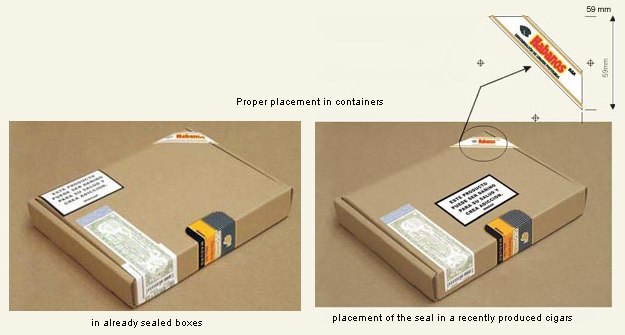
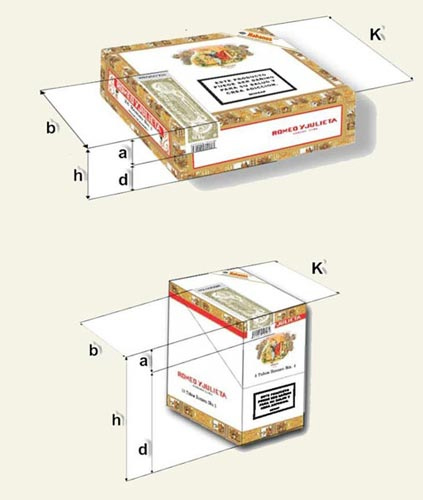

Second, Check for the Habanos Chevron on the top upper right corner of dress boxes and top lower-left corner of cabinets.
This label is ~13/16″ wide and features a black silhouette of a tobacco leaf followed by “Habanos” in bold red letters that are edge highlighted with yellow/orange. Also on the label are two gold stripes at the top and bottom and between them two fine black lines. This seal will be on all boxes of Havana cigars exported since 1994.
Third, On the bottom of the box look for the Hallmarks. Currently there are three branded hallmarks/logos and are in this order:
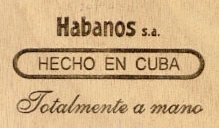 |
| These Hallmarks are not ink stamps, but are actual burned-in marks by the branding of the bottom of the boxes – you should run your fingers over them and feel their depth. |
“Habanos S.A.” in stylized letters – this is the name of current Cuban company which exports Havanas and will appear on all boxes exported since October 1994. Cubatobaco’s logo would appear in place of this hallmark on boxes between 1985 through September 1994.
“HECHO EN CUBA” in a simple font encircled by a straight-sided oval were added in 1960 to replace the same words, formerly in English, “Made in Cuba.”
“Totalmente a Mano” in script is the third hallmark and means “totally by hand.” This branding was added in 1989. These Hallmarks are not ink stamps, but are actual burned-in marks by the branding of the bottom of the boxes – you should run your fingers over them and feel their depth.
Fourth, Also on the bottom look for the factory and date stamp. These stamps use to be an excellent tool in helping to verify the authenticity of boxes of cigars, but in 1999 Habanos SA decided to change the entire NIVELACUSO coding to a new “top secret” format.
For all the Codes and far more detail on this subject we suggest you read our all encompassing Cigar Counsel article, “Year 2000 Habanos Box Codes.”

Fifth, Depending on where the box was distributed will determine some other common box labels and stamps that should be present. These seals and stamps are constantly changing and it is best to speak with a knowledgeable importer of Habanas in each individual country for the current information.
Sixth, also of some help are the various “health warning stickers” that some countries apply to their cigar boxes. Once again, these laws and their stickers vary, however knowing this info can prove to be helpful.
Seventh, Familiarize yourself with the different types of packaging in which Cuban cigars are enclosed. Various brands and sizes are packaged in certain styles of boxes including: Dress boxes, polished boxes, varnished and unvarnished cabinets, semi boite natural boxes, sliding lid boxes (SLBs – commonly referred to as cabinets), transit packs, and small pack Petacas. Sadly, it is impossible for me to generate a complete list of which cigars come in what packaging or even suggest a quality reference on this topic. Currently, my best advice is that you spend as much time as possible in a reputable tobacconist’s humidor examining the packaging they have on the shelves.
Eighth, The box should show little or no signs of wear and tear. Overly faded, nicked, and scratched boxes should be regarded as suspect since many counterfeiters utilize legit recycled boxes to help sell their inferior product.
Ninth, Here are some various boxes for you to examine more closely:
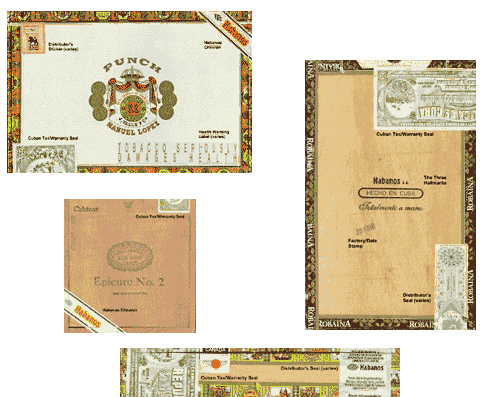
INSPECTING THE CIGARS THEMSELVES
First, The cigars will be of uniformed color and if there is any variation at all the cigars will be organized within the box with the darkest onesbeing placed on the left to the lightest one situated at the far right.

Second, The cigars will be of the exact length as specified for the vitola. There is rarely greater than 1/16th of an inch of deviation from the published lengths of Cuban cigars. This is probably the easiest counterfeit check to perform and it is seldom done.
Third, The ring gauges of the cigar should be as specified also. However, you will commonly witness slight deviations plus or minus a ring size. This is particularly true of cigars that are box pressed – remember the ring gauge is determined prior to the cigars being box pressed.
Fourth, Cuban cigars destined for export are typically very well made with solid bunching and close attention to detail. The tobacco should never be “booked.”
Fifth, Cuban Corojo wrappers are typically very finely veined, if at all.
Sixth, All ringed Cuban cigars should have tight clean bands with good color and embossing, if applicable, and should have the word “Habana” on it. They should show no signs of wear, creases, or glue stains as these are common indicators of rings that have been re-banded onto other cigars. With that said however, it is important that you not be overly critical of the rings as mis-registrations and imperfect embossing’s are not all that uncommon. In fact many of the mistakes are so common, they in themselves are proof the bands are legit.

Seventh, The foot of each cigar should be cut cleanly and evenly with no chipping.
Eighth, Inspect the cape (cap) of each cigar. Havana “parejos” (straight sided cigars) have a finely finished cap that is commonly referred to as the “triple cap.” You can actually see three fine lines from the flagging of the cap as it was wrapped around the head of the cigar. The cap on “figurados” are finished with a “switch back” flag – the wrapper is rolled the to the very tip of the head and trimmed to a thin strip which is then wound back in the same direction down the cigar.
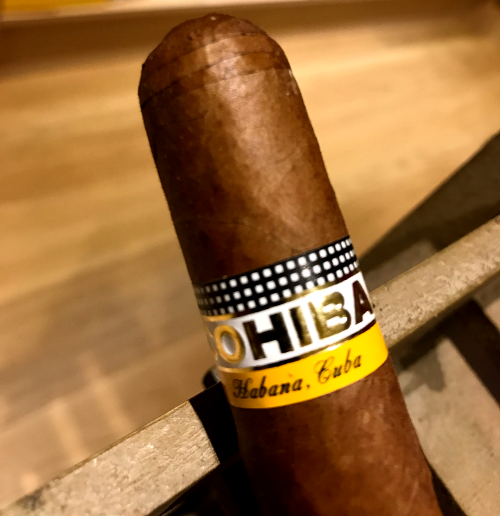
ADDITIONAL HELPFUL TIPS
First, Learn which cigars each Cuban factory manufactures and all of the correct names and sizes within their given lines. An excellent resource for this information is the Perelman’s Pocket Cyclopedia of Havana Cigars (ISBN 0-9649258-6-9). This is a must have resource for any Cuban cigar consumer. Another reputable source is www.cubancigarwebsite.com
Second, Learn the true market value of Cuban cigars – you will find that many counterfeiters sell them at far too low a cost to ever be legit. The maximum discount below list prices ever extended on Cuban cigars is 25% and this is very rare. Typically such discounts are afforded to the very best customers at the close of season. There is no such thing as a “bargain” when it comes to Cuban cigars. Also be careful if it’s online and also includes FREE shipping.
Third, Do not buy Havana’s from anyone that solicits you. There is a shortage of fine Habana’s in the world market, they simply sell themselves and do not need to be pushed.
Fourth, Avoid purchasing fake Cuban cigars from unknown parties particularly on the Internet. Always avoid buying Cuban cigars on Auction sites as there are many unscrupulous counterfeiters using this means to peddle their wares. Only deal with well-known and respected Havana cigar merchants as there are plenty to choose from worldwide. Most of the best online sources are located in Switzerland & Spain were re-export taxes are low. Avoid websites that have to good of a deal compared to other online websites in that same region as these sites are also purchasing grey market cigars from an unknown authorized Habanos dealers.
Fifth, Never buy any cigars that are billed as a “special edition”, “anniversary issue,” or some other specialty. Many counterfeiters will use this as a lead-on to explain away why the box is different or the cigar is a unique size. True special issue Habanas are exceedingly rare and are solely distributed between reputable dealers and serious collectors only, and for very big dollar amounts, literally thousands and sometimes tens of thousands per unit.
Sixth, Be wary of any store that will not sell you an entire box or allow you to have a box you just emptied with your purchase. Many less than reputable dealers will restock a legit box with fake cigars over and over again. This is a common practice amongst small market type stores and street side shops particularly in tourist towns.
Seventh, Be aware that some cigars are regularly counterfeited because they are more recognizable by the potential marks. For example, Cohibas Esplendidos, Romeo y Julieta Churchills, Hoyo de Monterrey Double Coronas, and Montecristo No. 2’s are commonly counterfeited because of their legendary status and their ability to fetch big money. Where as lesser know cigars such as the Saint Luis Rey Serie A, Rafael Gonzalez Lonsdale, and the Quai D’Orsay Churchill are rarely counterfeited because many cigar smokers would never recognize them as Havana’s making them difficult for counterfeiters to unload.
Eighth, It is commonly estimated that greater than 95% of the cigars in the US reputed to be Cuban are actually fakes. In my experience this is probably close to accurate, as I see fake after fake. Also, keep in mind that there are far more on average counterfeit Cuban cigars circulating in Florida, New York, and California.
Ninth, Always avoid purchasing cigars from anyone with a story that goes like, “I have a Cuban friend who goes from Miami to Havana weekly and buy cigars right in Cuba. He has a connection or cousin in the Cuban government, and he gets them real cheap then sells them up here for only $275 a box.” These type of lame stories are typical of the cover these counterfeiters use. Trust me every counterfeiter is either Cuban, is married to a Cuban, has a cousin who is Cuban, etc.
Tenth, Just because the cigars are from Cuba does not make them authentic premium Habanas. In fact, a good portion of the fakes on the market actually come from tourists who buy “Cuban” cigars from the throngs of street vendors. Most of these cigars are absolute crap. The only safe place to buy legit Havanas in Cuba is in a government state store.
Eleventh, Take a close look at this picture below. These cigars are FAKE. Period. I don’t care what anyone has told you, where they came from, how legit the seals and bands look, how well made the cigars are, or how great they taste. There is no such thing as authentic Cohiba Esplendidos, Robustos or Piramides in a “glass top” box. This is one of the biggest scams going and the tourists from Florida, through the Caribbean, and right to downtown Havana buy these boxes of “Fauxhibas” like crazy. This is by far the most notorious counterfeit Cuban cigar scam going – please don’t become another mark by purchasing a box of these cigars. Be careful of fake Cohiba Behike’s as these fetch more than other Cohiba ranges.

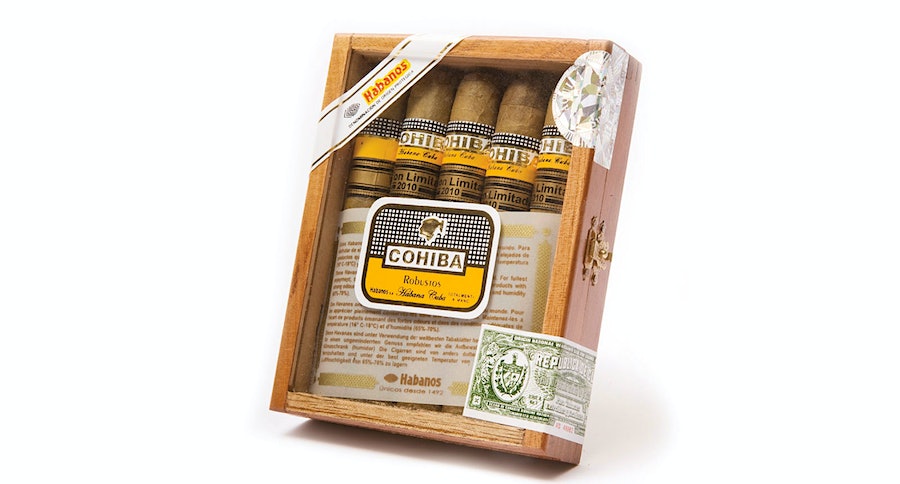
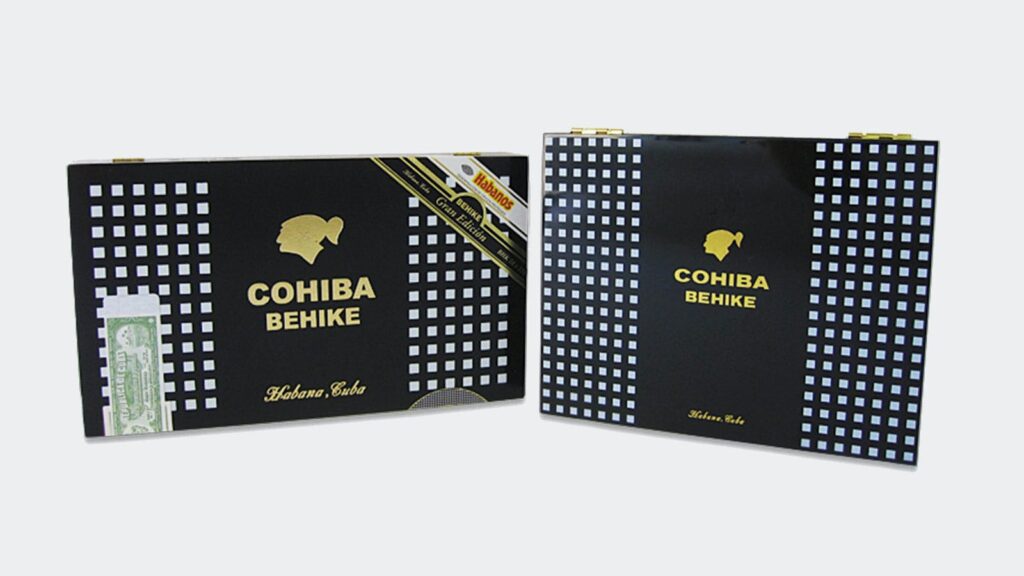
Twelvth, I have supplied you with a wide array of things to be critical of in your assessment of Havanas, however I want you to know that the Cubans are not often noted for the precision. It is not uncommon to find some small discrepancy such as a blurred factory stamp, a mis-embossed band, or poorly applied dress box labels. Therefore, it is important for you to look at every box in its totality when trying to determine whether it is authentic or not. If you are in doubt, it is best to simply not purchase the cigars.
Thirteenth, Know that it is NOT necessary to ever buy cigars on the black market or grey market. Almost all reputable and authorized Habanos dealers sell cigars with worldwide shipping, even if you live in the US. Remember, it is not illegal for them to sell them to you, rather it is illegal for you to buy them with American funds and to have them imported into the US. If you are willing to assume the legal and financial risks many will gladly take your order.
How to spot a Counterfeit or Fake Cuban Cigars – How to spot a counterfeit or fake Cuban Cigar, Spotting Fake Cuban Cigars, such as Cohiba, Montecristo, Punch, Bolivar and more.
Here is a link with a compiled list of known FAKE Cuban cigar websites and Facebook profiles online.
ALL FAKE CIGAR SHOPS LIST sourced from Cigar Analysis
(Updated 21.11.2022)
BlueHavenCigars.com
SoloCigars.com
FinestCigars.com
GoCubans.com with new name is RocketCigars.com
RoyalHabanos.com
SwissCubanCigars.com
VipCubanCigars.com
CubanCigarsBest.com
CigarSmokes.com
CubanCigarPlaza.com
LeopardCigars.com
BuyCubanCigarsOnline.com
HabanoStore.com
HabanosCr.com
CubanCigarLounge.com
Big-Smokers-Online.com
TrueCubanCigars.com
BestCubanCigars.com
CubanCigarExpert.com
LuxeCubanCigars.com
YouCigar.com
TrCigar.com
NyCigarLounge.com
OurCigar.net
CubanCigarOnline.com
Cubancigaraficionados.com
CubanHabanos.net
GetCigar.com
BestSellerCigars.com
FAKE CIGAR REVIEW BLOGS AND FACEBOOK PROFILE PAGES
(Updated 10.11.2022)
ZohoCigars.com (This blog is inactive right now)
These kinds of blogs are seen as cigar review blogs however their aim is totally different. They direct you to their own sale websites and those websites sell fake cigars also we have pointed out these websites above article;
SwissCubanCigars.com
VipCubanCigars.com
CubanCigarPlaza.com
CubanCigarBest.com
CubanCigarExpert.com
CigarSmokes.com
RocketCigars.com
FinestCigars.com
Finally, the most critical and trustworthy factor in being able to rightfully determine counterfeits cigars from true Havanas is personal experience. After you have seen, held, and opened hundreds of boxes of fine Cuban cigars all the above will become second nature. With the experience of having smoked thousands of these vitolas, you will be able to readily identify the look, feel, texture, taste, and aroma of legitimate Havanas. Cuban cigars have a certain bouquet and flavor that is uniquely their own. Some people simplify it by espousing that “if it looks good and tastes good – it is real” This conventional wisdom is a blatant falsehood as there are plenty of Havana vitolas that lack aesthetically and taste less than ideal, yet are authentic Cuban cigars. With experience your nose and palate will not only begin to learn to identify fake from real Cuban cigars, but also good vs. bad, young vs. old, and even the specific vitolas themselves from their aroma and flavor alone. Granted this will take many cigars and many years, but I assure you the effort of acquiring this noteworthy skill is an absolute pleasure.
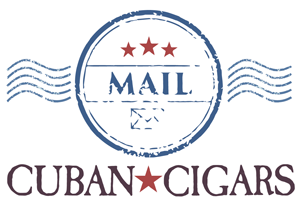
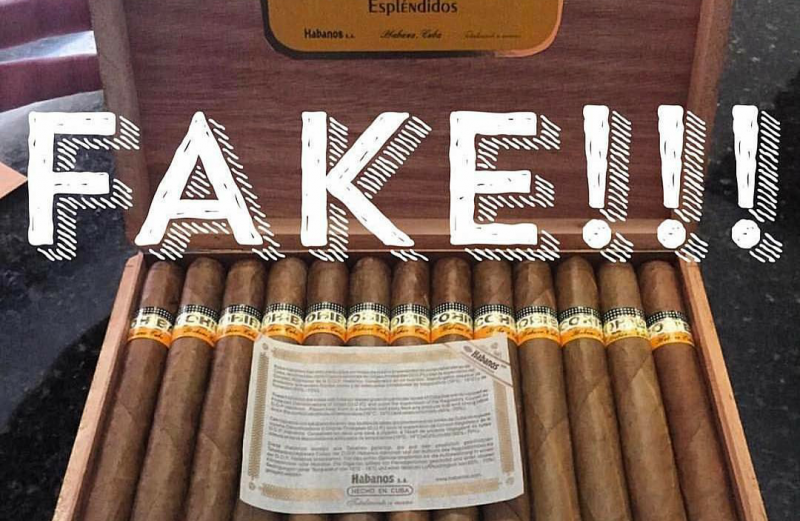
Thanks, invaluable information. 👌🏼👍🏿
Wow, that’s a lot of information and I thought I knew enough. I see that bundles are being made with tobacco from multiple companies with no bands at a very reduced price. Look ok. Thanks for the help.
“After you have seen, held, and opened hundreds of boxes of fine Cuban cigars all the above will become second nature. With the experience of having smoked thousands of these vitolas, you will be able to readily identify the look, feel, texture, taste, and aroma of legitimate Havanas.”
I’ll get right on that. Have you got a few thousand Cubans I can smoke?